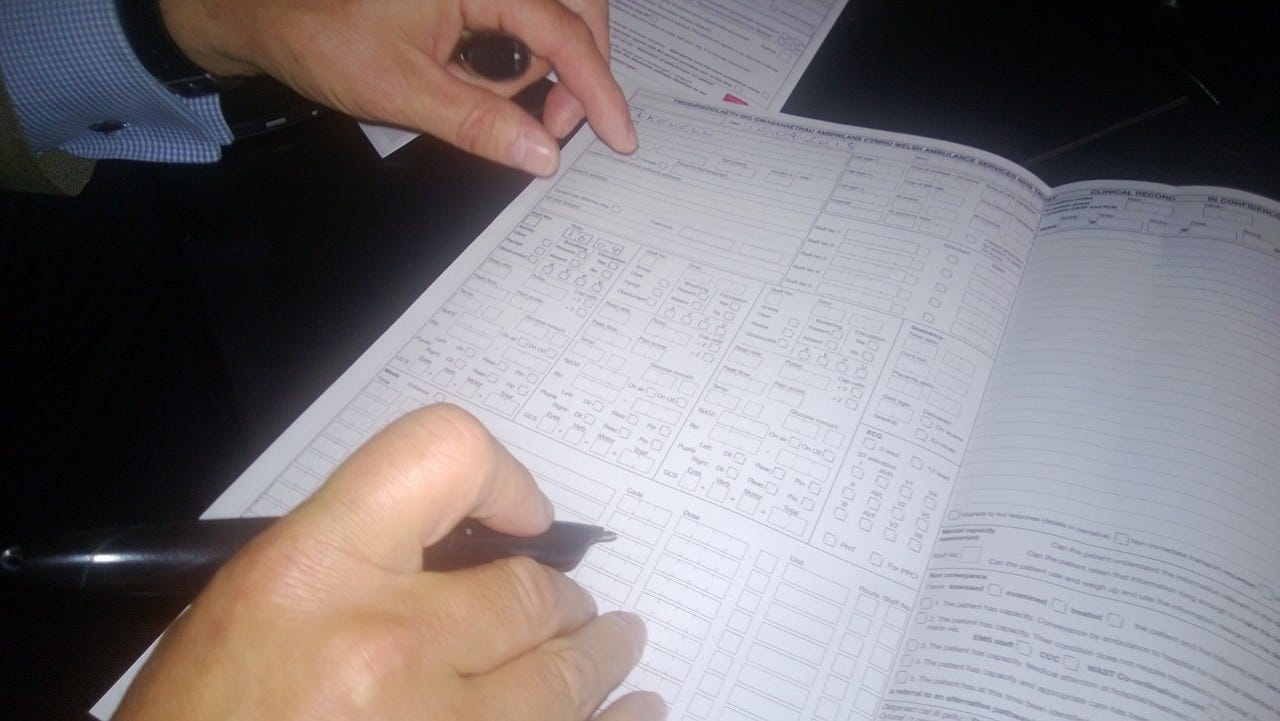Digitising the undigitisable, one page at a time

Over the past couple of decades we've digitised nearly every business process possible.
I should know: I've played a part in building the tools to do so in some really quite unusual projects back in my coding days (including delivering cement chemical analyses to engineers building highways before they mixed concrete, rather than after as was too often the case). But there were some that were just too difficult to digitise, for many reasons: cost, danger, the environment in which they took place.
One of the more complex processes — and one of the most critical — is capturing patient information in an ambulance. It might be as easy as bringing someone in for a check-up after a fall, or as complex as dealing with casualties from a major road traffic accident. The paramedics in the ambulance need to capture as much information as possible, ready to hand over to hospital staff with the patient.
That means using pen and paper; it's fast, reliable, and ensures that the information captured is accurate as possible. It can be used while the ambulance is rushing to the ER, jotting notes while trying to save lives.

The forms used are large — much larger than a typical tablet screen, and contain a mix of text fields, image fields, and tick boxes. That makes them hard to digitise; for one thing, modern tablets' capacitive screens don't have the resolution needed for sketches.
So how to make this part of a modern electronic medical process, where the patient information doesn't need to be transcribed in the ER, and where the original forms don't need to be picked up by couriers at the end of each shift?
The answer turns out to be quite simple: use a digital pen to capture strokes and feed them into a digital copy of the form. Last week I sat down with a team from Anoto to look at the work they've been doing with one of the UK ambulance services.
Anoto's digital pen is designed for this type of scenarios, using a pattern of almost invisible dots printed on the paper to capture strokes and position accurately via a sensor built into the pen. A wireless link to a mobile device can upload the captured data when triggered by a special pattern on the page.
I knew that the forms were big, but the size and complexity of the document that needs to be filled out astounded me: it's approximately A3, full of detailed information that needs to be completed accurately. Using an Anoto pen, a paramedic would fill out the form, and when complete, tick a box.
That would trigger the pen to send its store of data via a smartphone to a server which would use text recognition to translate the handwritten text to fields in an electronic form — which could then be delivered to the hospital or ER, ready for use.
The result is an interesting hybrid of the analog and the digital, which takes an existing (and highly complex) process and digitises it without having to change the way the front-end works. That means there's no need to take skilled paramedics out of the frontline, where they're desperately needed, for training.
It also means there's no need to invest in expensive hardware that may not be able to handle the conditions in the back of a speeding ambulance. All that's needed is a relatively low-cost, and extremely reliable digital pen, along with a standard smartphone to connect it to the form-processing servers over existing 3 and 4G networks and the public Internet.
It's even possible to embed special functions into a page: what was once a piece of paper is actually a user interface to a wide selection of applications and services, all accessed without exposing expensive and fragile hardware.
While the digital paper forms may be a little more expensive than the original versions, thanks to the dot pattern needed by the pens, they're still relatively cheap — and let you run the old paper processes alongside the new purely digital system. And of course, if you want to go completely digital Anoto recently announced support for its pen technology on Panasonic's 4K 20-inch tablet — which has more than enough pixels to display the pen pattern underneath text and images.